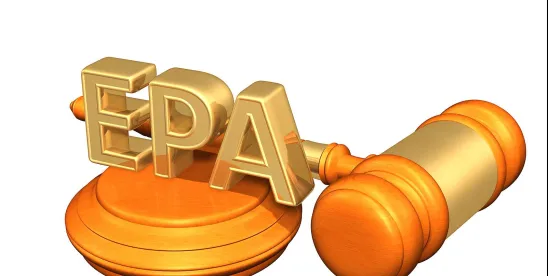On February 4, new US Environmental Protection Agency (EPA) Administrator Lee Zeldin announced EPA’s “Powering the Great American Comeback Initiative,” which is intended to achieve EPA’s mission “while emerging the greatness of the American Economy.” The initiative has five “pillars” intended to “guide the EPA’s work over the first 100 days and beyond.” These are:
- Pillar 1: Clean Air, Land, and Water for Every American.
- Pillar 2: Restore American Energy Dominance.
- Pillar 3: Permitting Reform, Cooperative Federalism, and Cross-Agency Partnership.
- Pillar 4: Make the United States the Artificial Intelligence Capital of the World.
- Pillar 5: Protecting and Bringing Back American Auto Jobs.
Below, we break down each of the five pillars and present context what these pillars may mean to the regulated community.
Pillar 1: “Clean Air, Land, and Water for Every American”
The first pillar is intended to emphasize the Trump Administration’s continued commitment to EPA’s traditional mission of protecting human health and the environment, including emergency response efforts. To emphasize this focus, accompanied by Vice President JD Vance, Zeldin’s first trip as EPA Administrator was to East Palatine, Ohio, on the two-year anniversary of a train derailment. While there, Administrator Zeldin noted that the “administration will fight hard to make sure every American has access to clean air, land, and water. It was an honor to meet with local residents, and I leave this trip more motivated to this cause than ever before. I will make sure EPA continues to clean up East Palestine as quickly as possible.” After surveying the site of the train derailment to survey the cleanup, Zeldin and Vance “participated in a meeting with local residents and community leaders to learn more” about how to expedite the cleanup.
Taken alone or in conjunction with Administrator Zeldin’s trip to an environmentally impacted site in Ohio, Pillar 1 appears consistent with past EPA practice.
Read in the context of the Trump Administration’s first-day executive orders (for more, see here) and related actions such as a memoranda from Attorney General Pam Bondi on “Eliminating Internal Discriminatory Practices” and “Rescinding ‘Environmental Justice’ Memoranda.” Pillar 1 should be construed as meaning that EPA no longer intends to proactively work to redress issues in “environmentally overburdened” communities. Consequently, programs under the Biden Administration that focus on environmental justice (EJ) and related equity issues are ended. (For more, see here.)
Pillar 2: Restoring American Energy Dominance
Pillar 2 focuses on “Restoring American Energy Dominance.” What this means in practice is little surprise given President Trump’s promises during his inauguration to “drill, baby, drill.” Two first-day Executive Orders provide further context to this pillar:
- The Executive Order “Declaring a National Energy Emergency” declares a national energy emergency due to inadequate energy infrastructure and supply, exacerbated by previous policies. It emphasizes the need for a reliable, diversified, and affordable energy supply to support national security and economic prosperity. The order calls for immediate action to expand and secure the nation’s energy infrastructure to protect national and economic security.
- The Executive Order on “Unleashing American Energy,” seeks to encourage the domestic production of energy and rare earth minerals while reversing various Biden Administration actions that limited the export of liquid natural gas (LNG), promoted electric vehicles and energy efficient appliances and fixtures, and required accounting for the social cost of carbon. (For context on the social context of carbon, see here and here.)
Pillar 3: Permitting Reform, Cooperative Federalism, and Cross-Agency Partnership
Pillar 3 focuses on government efficiency including permitting reform, cooperative federalism, and cross-agency partnerships. As with Pillar 1, two of these goals (cooperative federalism and cross-agency partnership) are generally consistent with typical agency practice across all administrations even if administrations approach them in different ways.
“Permitting reform” generally means streamlining the permitting processes so that the time from permitting submission to conclusion is shorter.
Current events, most notably three court decisions involving the National Environmental Policy Act (NEPA), require a deeper exploration of “permitting reform.” NEPA is a procedural environmental statute that requires federal agencies to evaluate the potential environmental impacts of major decisions before acting and provides the public with information about the environmental impacts of potential agency actions. The Council on Environmental Quality (CEQ), an agency within the Executive Office of the president, was created in 1969 to advise the president and develop policies on environmental issues, including ensuring that agencies comply with NEPA by conducting sufficiently rigorous environmental reviews.
Energy-related infrastructure ranging from transmission lines to ports needed to ship LNG often require NEPA reviews. During his first term, President Trump sought to streamline NEPA reviews. As we previously discussed, in 2020, CEQ regulations were overhauled to exclude requirements to discuss cumulative effects of permitting and, among other things, to set time and page limits on NEPA environmental impact statements. During the Biden Administration, in one phase of revisions, CEQ reversed course to undo the Trump Administration’s changes, and, in a second phase, the Biden Administration required evaluation of EJ concerns, climate-related issues, and increased community engagement. (For more, see here.) Predictably, litigation followed these changes. Additionally, we are waiting on the US Supreme Court’s decision in Seven County Infrastructure Coalition v. Eagle County, Colorado, which addresses whether NEPA requires federal agencies to identify and disclose environmental effects of activities which are outside their regulatory purview.
These two recent decisions add to the ongoing debate about whether CEQ ever had the authority to issue regulations that have been relied upon for decades. These include the DC Circuit’s decision in Marin Audubon Society v. FAA (for more, see here) and a second decision by a North Dakota trial court in in Iowa v. Council on Environmental Quality.
Pillar 4: Make the United States the Artificial Intelligence Capital of the World
EPA’s Pillar 4 seeks to promote artificial intelligence (AI) so that America is the AI “Capital of the World.”
AI issues fall into EPA’s purview because development of AI technologies is highly dependent on electric generation, transmission, and distribution. EPA plays a key role in overseeing permitting and compliance activities related to facilities like these. As we have discussed, AI requires significant energy to power the data centers it needs to function, and a study indicates that the carbon footprint of training a single AI natural language processing model produced similar emissions to 125 round-trip flights between New York and Beijing. Because data center developments tend to be clustered in specific regions, more than 10% of the electricity consumption in at least five states is used by data centers. (Report available here.)
Pillar 5: Protecting and Bringing Back American Auto Jobs
Pillar 5 focuses on supporting the American automobile industry. As was discussed in relation to Pillar 2, EPA seeks to support the American automobile industry. Regarding this sector, EPA intends to “streamline and develop smart regulations that will allow for American workers to lead the great comeback of the auto industry.” Additionally, the US Office of Management and Budget released a memo on January 21, clarifying that provisions of the “Unleashing American Energy” Executive Order were intended to pause disbursement of Inflation Reduction Act funds, including those for electric vehicle charging stations.
While the particulars of this pillar are less clear than some others, we expect that EPA’s efforts in this area will involve some combination of permitting reform and rollback to prior EPA decisions related to vehicle emissions.




 />i
/>i

